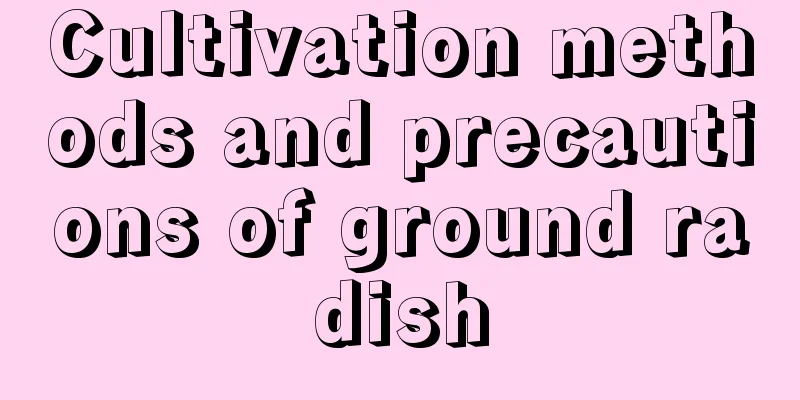Cultivation methods and precautions of ground radish

1. Maintenance methods1. Temperature: It is cold and heat resistant, and can be cultivated in most parts of my country. As long as the maintenance temperature is guaranteed to be between zero and thirty degrees, it can grow normally. However, if the maintenance temperature is maintained at around 20 degrees, it will grow better because the best maintenance temperature is 20 degrees. 2. Watering: There is plenty of rainfall in the south, so drainage is needed during the rainy season. From July to September, the temperature is high and the soil is prone to drought. The plants need to be watered. Depending on the growth status of the plants, water should be replenished once every one to two weeks. Do not water too much. The standard is that the surface should be wet but not visible, and dry but not cracked. 3. Fertilization: It is a low-fertilizer consumption plant and does not require much nutrients. Before planting, you need to mix base fertilizer into the soil. Thirty days after planting, you need to apply organic fertilizer to the soil. The consumption of nutrients increases during the bud and fruiting periods, so it is sufficient to apply compound fertilizer once a month. 4. Light: It does not require much light. It needs natural light in spring and winter, and shade in summer and autumn. The daily sunlight is guaranteed to be around five hours. 2. Breeding techniques1. Reproduction: The cutting method can be used to reproduce ground radish. Around the Qingming Festival, select plants with better growth, divide them into 10*10 small squares with a shovel, and transplant them with soil according to the specifications of 30*30. Diffuse light is needed when exposing them to sunlight, and water is needed to help them take root after planting. 2. Overwintering: The roots of the ground radish produced in the same year are not long, and are mainly creeping roots. Its frost resistance is weak. When the temperature is below minus four degrees, the plant will be frostbitten and cannot safely overwinter. Therefore, a layer of plastic film should be laid on the surface of the plant to prevent frost before the low temperature comes. 3. Problem Diagnosis1. Pests: Artificially cultivated plants are not currently attacked by pests, so generally no drug control is required. 2. Disease: It has a very strong survival ability and generally will not develop disease. However, just in case, it needs to be sprayed with carbendazim every month. IV. Other issues1. Edibility: Its fruit is a berry that is rich in vitamin C and can also be made into a calcium supplement. 2. Other functions: It can not only be used, but also can be used to extract pigments for food processing. It is a natural pigment. |
<<: Cultivation methods and precautions of ground vegetables
>>: Cultivation methods and precautions of Trichosanthes kirilowii
Recommend
How often should you water garlic?
How often should you water garlic? The first wate...
Ten trees you shouldn’t plant at home
1. Mulberry The word “桑” in “mulberry tree” has t...
How to reproduce the yellow candy orchid
Division Using this method, it can basically be d...
The efficacy and function of stealing clothes
1. Treat roundworms The efficacy of Chinese medic...
How to grow spider plants so that they can grow vines
1. Reasonable lighting If you want the spider pla...
How to grow Verbena on the balcony, what should you pay attention to
1. Adequate lighting If you want to ensure that p...
How to trim the green treasure tree to make it look good
When is the right time to prune the green tree? I...
Willow's growth environment and local conditions
Willow Growth Environment and Conditions Willow c...
Can anthuriums be placed in the bedroom? What plants can be placed in the bedroom?
1. Can I put it? It is a plant with a very beauti...
Can peacock arrowroot be planted in the bedroom?
Is the peacock plant suitable for indoor maintena...
How does bougainvillea stop growing in summer? (Why does bougainvillea stop growing in summer?)
What should I do if bougainvillea stops growing i...
Radish lotus cultivation methods and precautions
Radish lotus is actually very easy to grow. First...
Three major cultivation methods of daffodils
Hydroponics of daffodils Hydroponics is the most ...
How much does it cost to build a vegetable shed per acre (how much does it cost to build a vegetable shed per acre)
Today's steel frame vegetable greenhouses use...
Where is the best place to plant jasmine?
Sunny place Jasmine is a very positive flower pla...









